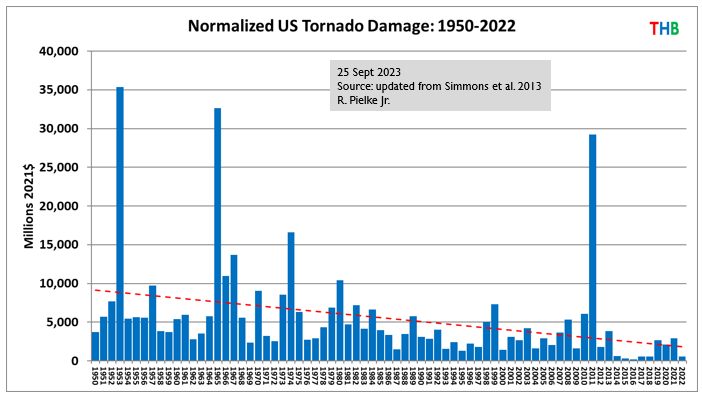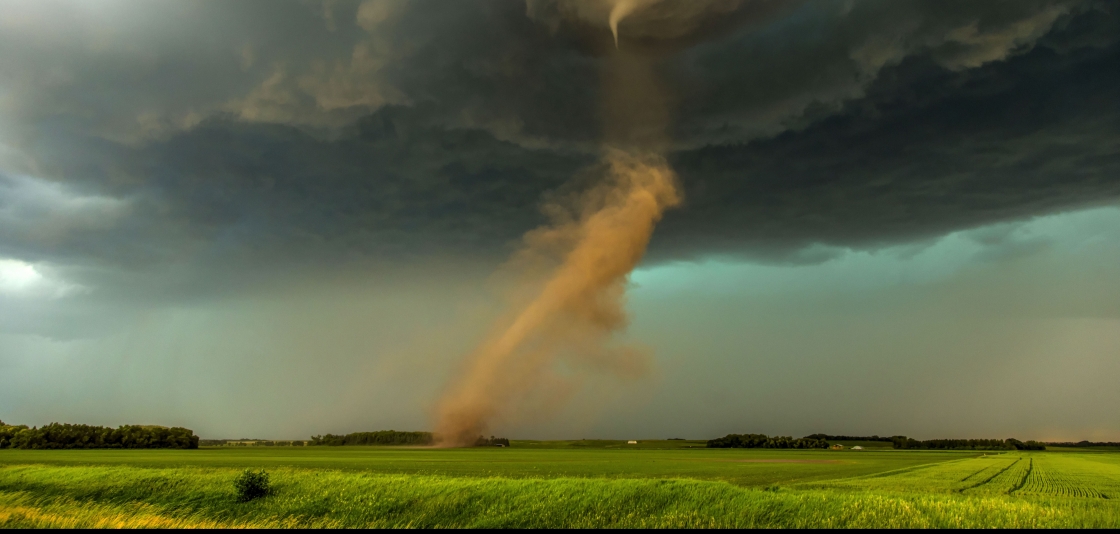View this page as a printable PDF here: CAAG-Tornadoes
Key Takeaways:
- The number of tornadoes and strong and violent tornadoes, rated EF3 or higher, have been dramatically declining for decades.
- In 2017-2018, the United States set a record for the longest period in history without a tornado death.
- In 2017-2018, the United States set a record for the longest period in history without an F3 or stronger tornado.
- The two record-low years for number of tornadoes both occurred this past dozen years– 2014 and 2018.
- According to a report by the United Nations, “There is low confidence in observed trends in small spatial-scale phenomena such as tornadoes.”
Short Summary:
Tornadoes typically form when very cold, dry air clashes with warm, humid air. Climate change warms the Arctic more than the tropics and subtropics, resulting in less of a clash between cold Arctic air masses and warm Gulf of America air masses. As a result, fewer and less-violent tornadoes are occurring today than in previous periods.1,2
The number of tornadoes in the United States, and globally, has been declining for decades. Also, the number of strong to violent tornadoes, EF3 or higher, has sharply declined over the past 70 years. (See Figure 1.) In fact, the United States set a record in 2017–18 for the longest period in recorded history without a tornado death, and it set a record for the longest period in history (306 days) without an EF3 or stronger tornado.3,4 The two record-low years for tornado strikes in the United States both occurred this past decade, in 2014 and 2018.5
Even the UN Intergovernmental Panel on Climate Change has acknowledged, “There is low confidence in observed trends in small spatial-scale phenomena such as tornadoes.”6
Figure 1. U.S. Annual Count of Strong to Violent Tornadoes (EF3+), 1955–2024
Figure 1. This figure shows the frequency of strong to violent tornadoes (tornadoes registering EF3 or stronger) has been declining since the early 1970s. Sources: Graph by Anthony Watts and David Burton using official NOAA/Storm Prediction Center data.7,8,9
A recent peer-reviewed paper, Time trends in losses from major tornadoes in the United States, confirms that U.S. tornado damage and strong tornado incidence are both sharply down.10 (See Figure 2, below).


Figure 2: Normalized US Tornado Damage from 1950-2022. Graph by Roger Pielke, Ph.D, updated from data in Simmons et al. 2013. Red dashed line indicates the trend.
References:
- Nsikan Akpan, “Is Climate Change Making U.S. Tornadoes Worse?,” Public Broadcasting Service, March 5, 2019, https://www.pbs.org/newshour/science/is-climate-changemaking-u-s-tornadoes-worse
- Bob Berwyn, “Is Climate Change Fueling Tornadoes?,” Inside Climate News, May
30, 2019, https://insideclimatenews.org/news/30052019/tornado-climate-changeconnection-science-research-data - Doyle Rice, “U.S. Sets Record of 246 Straight Days without a Tornado Death,” USA Today, January 17, 2018, https://www.usatoday.com/story/weather/2018/01/17/u-ssets-record-246-straight-days-without-tornado-death/1041125001
- Chris Dolce, “Record-Long Streak With No EF3 or Stronger Tornadoes in the U.S. Ends in Jacksonville, Alabama,” The Weather Channel, March 18, 2018, https://weather.com/storms/tornado/news/2018-03-21-jacksonville-alabama-tornado-ends-ef3-unitedstates-
drought - Doyle Rice, “2018 Was an All-Time Record Quiet Year for Tornadoes in the U.S.,” USA Today, December 28, 2018, https://www.usatoday.com/story/news/nation/2018/12/28/
tornadoes-set-record-lows-2018-only-10-deaths-us/2431360002 - U.N. Intergovernmental Panel on Climate Change, Changes in Climate Extremes and Their Impacts on the Natural Physical Environment, Chapter 3, 2018, accessed August 16, 2021,https://www.ipcc.ch/site/assets/uploads/2018/03/SREX-Chap3_FINAL-1.pdf
- National Oceanic and Atmospheric Administration, “Historical Records and Trends,” accessed January 24, 2025, https://www.ncdc.noaa.gov/climate-information/extreme-events/us-tornado-climatology/trends
- Daniel McCarthy and Joseph Schaefer, “Tornado Trends over the Past Thirty Years,” NOAA, National Weather Service, NWS, NCEP, Storm Prediction Center, accessed 8/16/21, https://www.spc.noaa.gov/publications/mccarthy/tor30yrs.pdf
- Graph data from National Oceanic and Atmospheric Administration’s National Weather Service, Storm Prediction Center website, accessed January 24, 2025 https://www.spc.noaa.gov/wcm
- Zhang et al., “Time trends in losses from major tornadoes in the United States,” ScienceDirect, Weather and Climate Extremes, Volume 41, September 2023, accessed September 29, 2023, https://doi.org/10.1016/j.wace.2023.100579
Climate At A Glance is a Project of The Heartland Institute
View this page in our printable booklet (PDF) here.
Email: think@heartland.org
Photo: NOAA NWS, Amanda L. Hill | A tornado in eastern North Dakota on June 27, 2015.



